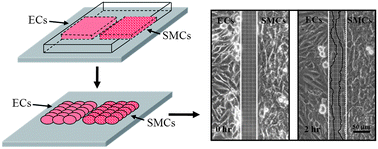Using a co-culture microsystem for cell migration under fluid shear stress
Abstract
We have successfully developed a microsystem to co-cultivate two types of cells with a minimum defined gap of 50 μm, and to quantitatively study the impact of fluid shear stress on the mutual influence of cell migration velocity and distance. We used the hydrostatic pressure to seed two different cells, endothelial cells (ECs) and smooth muscle cells (SMCs), on opposite sides of various gap sizes (500 μm, 200 μm, 100 μm, and 50 μm). After cultivating the cells for 12 h and peeling the co-culture microchip from the culture dish, we studied the impacts of gap size on the migration of either cell type in the absence or presence of fluid shear stress (7 dyne cm−2 and 12 dyne cm−2) influence. We found that both gap size and shear stress have profound influence on cell migration. Smaller gap sizes (100 μm and 50 μm) significantly enhanced cell migration, suggesting a requirement of an effective concentration of released factor(s) by either cell type in the gap region. Flow-induced shear stress delayed the migration onset of either cell type in a dose-dependent manner regardless of the gap size. Moreover, shear stress-induced decrease of cell migration becomes evident when the gap size was 500 μm. We have developed a co-culture microsystem for two kinds of cells and overcome the conventional difficulties in observation and mixed culture, and it would have more application for bio-manipulation and tissue repair engineering.


 Please wait while we load your content...
Please wait while we load your content...